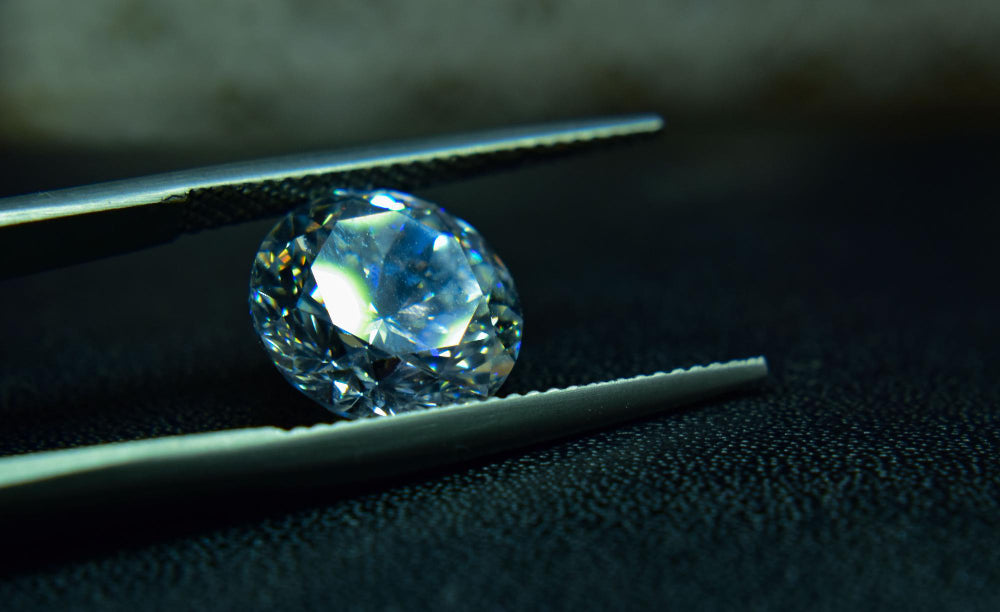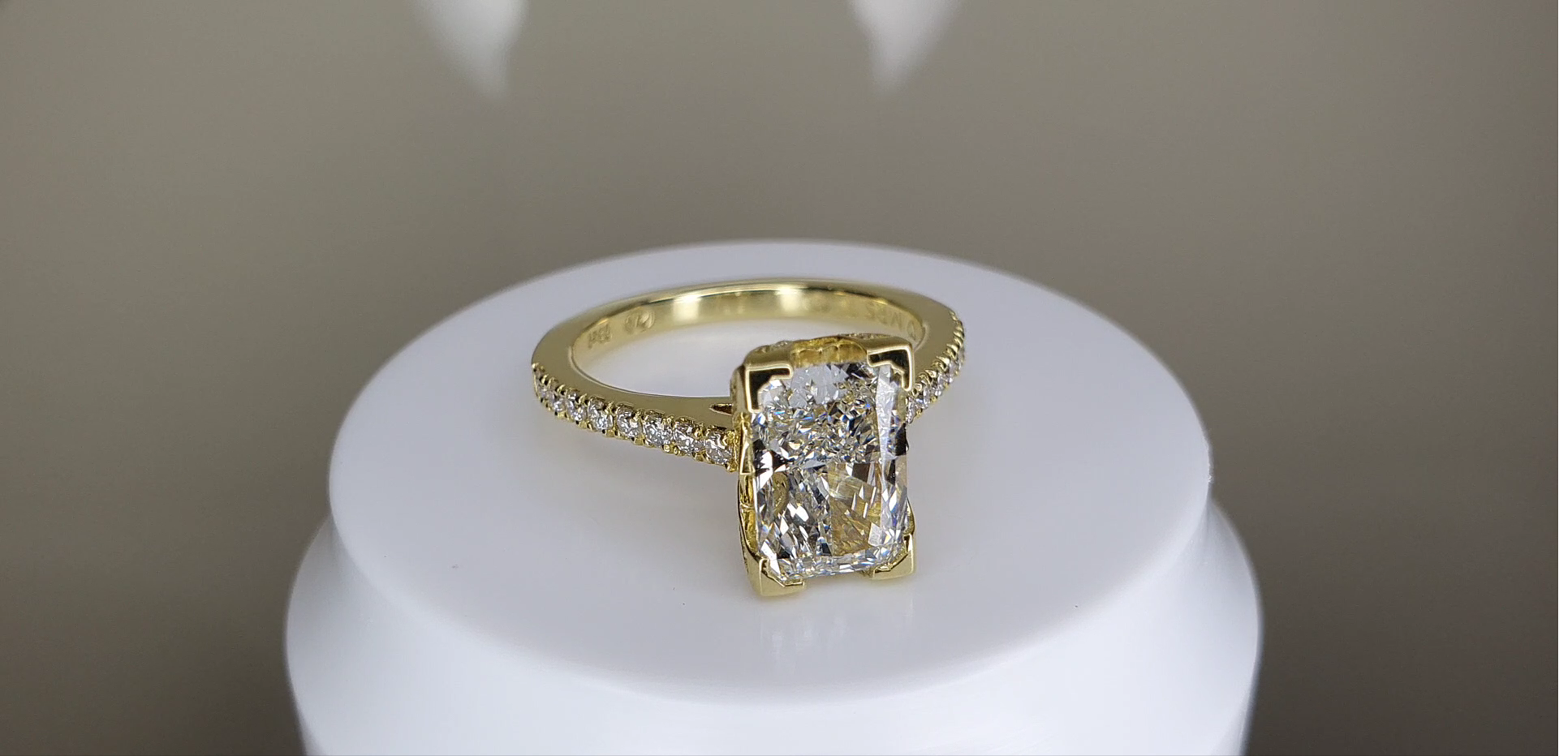
Diamond VS. Moissanite
The 4'C of a Diamond vs.
The 4'C of a Moissanite
Diamond vs. Moissanite
Laboratory Certification
Diamond Grading vs. Moissanite Grading
The certification of diamonds and moissanite are different due to the nature of the gemstones and the purpose of certification. Diamonds are usually certified by reputable organizations such as the Gemological Institute of America (GIA) or the International Gemological Institute (IGI). These organizations use a rigorous process to evaluate a diamond's quality based on its cut, color, clarity, and carat weight, and issue a certificate that attests to the diamond's authenticity and quality. Moissanite, on the other hand, is typically certified by its manufacturer. This certification attests to the authenticity of the moissanite and provides information on the gemstone's origin, quality, and physical characteristics. Moissanite certification is usually not as comprehensive as diamond certification, as moissanite is not as valuable or widely sought after as diamonds. However, it is still an important aspect of purchasing moissanite jewelry, as it provides assurance to the buyer that they are receiving a genuine product. In conclusion, while the certification process for diamonds and moissanite are different, both are crucial for ensuring the authenticity and quality of the gemstones and provide peace of mind to the buyer.
Diamond vs. Moissanite
Natural vs. Laboratory Grown
Natural Diamond vs. Laboratory Grown Moissanite
Diamonds are formed naturally over millions of years in the Earth's mantle under extreme heat and pressure. Moissanite, on the other hand, is a mineral that was first discovered in a meteorite in 1893, but the gem-quality variety used in jewelry today is lab-grown using high-temperature, high-pressure (HT-HP) techniques to recreate the same conditions under which natural moissanite is formed. The lab-grown moissanite has similar physical and optical properties to diamonds, but is less expensive and can be made to exact specifications. While moissanite is always lab-created, diamonds can also undergo treatment to improve their colour and clarity. This is common in the diamond industry and is often not disclosed to consumers. However, because diamonds are naturally occurring, they are still referred to as diamonds even after undergoing treatment. The term "natural diamond" is used to distinguish them from lab-grown diamonds, which are a separate category of gemstones.
Diamond Durability vs. Moissanite Durability
In terms of durability and lifetime, diamond is considered the hardest and most durable gemstone and is known to last a lifetime. Moissanite, on the other hand, is also durable and long-lasting, but it is not as hard as diamond.
In terms of jewelry, diamond is considered the best gemstone due to its high value, durability, and timeless beauty. Moissanite, while less expensive than diamond, is also a good choice for jewelry due to its durable and long-lasting properties. Ultimately, the choice between diamond and moissanite for jewelry will depend on personal preference, budget, and intended use.
Both Diamond and Moissanite are long-lasting gemstones and will last a lifetime. However, because Moissanite is a lab-grown gemstone, some consumers tend to be wary of its quality and durability. To address this, Ralph Jacobs offers a lifetime warranty on all their Moissanites, ensuring that if the Moissanite were to change color or lose its sparkle, they would be exchanged. This warranty serves as a testament to the quality and durability of Moissanite and provides peace of mind for consumers who are considering purchasing a Moissanite for their jewelry.
Frequent Questions
Diamond Price vs. Moissanite Price
Diamonds and Moissanite are two popular gemstones used in jewelry. While both gems are beautiful and sparkly, they differ in their prices, sourcing, and stability.
Diamonds are generally considered to be more expensive than Moissanite. This is due to several factors, including the scarcity of natural diamonds, the high cost of mining and processing diamonds, and the long-standing reputation and demand for diamonds as a luxury item.
The price of a diamond can vary greatly based on its quality, size, and cut, with high-quality, large diamonds commanding premium prices.
Diamonds are traditionally sourced from various countries, with South Africa being one of the largest producers. However, the majority of diamonds mined in South Africa are exported and then re-imported into the country. This means that the price of diamonds is linked to the USD to ZAR exchange rate, which can fluctuate. The price of a diamond today can change tomorrow.
Moissanite, on the other hand, is a synthetic gemstone that is created in a laboratory. It is made from silicon carbide and is known for its near-identical appearance to diamonds.
The price of Moissanite is fixed in ZAR and is not affected by exchange rate fluctuations. This means that the price of Moissanite is more stable and predictable, making it an attractive alternative to diamonds for consumers looking for a budget-friendly option.
In conclusion, both diamonds and Moissanite are beautiful gems that have their own unique characteristics. While diamonds are subject to price fluctuations due to their sourcing and exchange rate linkage and due to their scarcity and reputation as a luxury item, Moissanite offers a more stable and predictable pricing option. Ultimately, the choice between the two will come down to personal preference, budget, and the intended use of the gemstone.





